Marty Halpern's Blog, page 36
July 1, 2012
Reviewing the Apocalypse
I've thoroughly enjoyed reading Stross' 'Laundry' series for years now and seeing how Britain's brave secret agents fight creatures from extra-dimensional space whilst dealing with the latest round of meetings and Civil Service budget cuts. Having worked in government I find this really funny because it's true (the bureaucracy I mean, not the extra-dimensional creatures...)
—Graeme Flory, Graeme's Fantasy Book Review
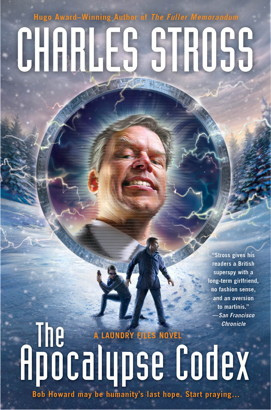 Earlier this year, on January 27, I posted a blog update entitled "Doing Charles Stross's Laundry with Style," in which I wrote about working on the author's newest Laundry Files novel,
The Apocalypse Codex
Earlier this year, on January 27, I posted a blog update entitled "Doing Charles Stross's Laundry with Style," in which I wrote about working on the author's newest Laundry Files novel,
The Apocalypse Codex
 , for Ace Books. And, specifically, that the publisher required that I provide a Style Sheet along with the edited manuscript.
, for Ace Books. And, specifically, that the publisher required that I provide a Style Sheet along with the edited manuscript.The Apocalypse Codex will be published this month and the reviews are starting to appear. All very positive, so far....
I opened this blog post above with a quote from Graeme Flory's review on his Fantasy Book Review blog. Here is another snippet from his review:
...Stross appears to be of the mind that he is done explaining all the technical stuff that underpins this setting....We've had a few books for it all to sink in and now it's time for the plot itself to have some room to breathe. It's a great move on Stross' part; his plots are normally brimming over with cool stuff anyway but the extra room allows things to ramp up to another level.
And Graeme concludes his review with:
...there are still some nasty surprises in store to trap unwary characters and make The Apocalypse Codex a book that you simply have to finish. My only regret is that I finished the book too quickly and now I have to wait for ages until the next installment.
I suspect every author would like to read a review of their work end like that!
The second review is from Elias F. Combarro (@odo), whose name you may recognize on this blog. In a blog post on May 9, I linked to Odo's review of my Alien Contact
 anthology on his Spanish-language blog Sense of Wonder. If Spanish isn't your thing, Odo also now posts all his reviews in English as well. As a follow-up to his review, Odo also interviewed me about a week later. I've included a link to the interview in that previous blog post as well.
anthology on his Spanish-language blog Sense of Wonder. If Spanish isn't your thing, Odo also now posts all his reviews in English as well. As a follow-up to his review, Odo also interviewed me about a week later. I've included a link to the interview in that previous blog post as well.But back to The Apocalypse Codex -- Odo writes in his review:
I found The Apocalypse Codex a bit closer to urban fantasy than the previous books in the series, and some parts even reminded me of The Magician King by Lev Grossman and Kraken by China Miéville. The plot is tighter, more interesting and easier to follow than some of the other novels of The Laundry Files.
And the last paragraph of his review ends with a dire warning:
All in all, The Apocalypse Codex is possibly the best novel of The Laundry Files (and my favorite book of 2012 so far, together with Existence by David Brin) and that is a lot to say. Buy it. Read it. You don't know when CASE NIGHTMARE GREEN will happen and you'd better be prepared.
Orbit Books, the U.K. publisher of TAC, has kindly made the book's Prologue available online for your reading pleasure. So, if you're not already familiar with The Laundry and Bob Howard, here's your chance for a sneak peak at the new novel.

Published on July 01, 2012 17:37
June 28, 2012
Is Anybody Out There? -- Variant Covers and a Second Printing
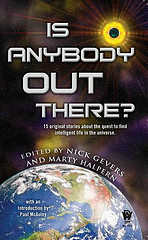 While attending SETIcon II this past weekend, one of the attendees, who was purchasing a copy of my co-edited anthology
Is Anybody Out There?
While attending SETIcon II this past weekend, one of the attendees, who was purchasing a copy of my co-edited anthology
Is Anybody Out There?
 (Daw Books, 2010), pointed out to me not only a difference in the books' covers but also that some of the books were a second printing. Learning that your book has sold well enough to necessitate a second printing is always great news. And to learn, too, of the cover variants was surprising as well.
(Daw Books, 2010), pointed out to me not only a difference in the books' covers but also that some of the books were a second printing. Learning that your book has sold well enough to necessitate a second printing is always great news. And to learn, too, of the cover variants was surprising as well.In preparation for SETIcon, I had previously ordered a number of copies of Is Anybody Out There? direct from Penguin Group (USA) Inc. Aside from checking that the number of books in the box was accurate and that none were damaged, well, that was as far as my keen observations went.
I've tried to scan the covers to show the differences, but the glare and all prohibits such distinctions. So, I will do my best to explain.
For all you completists out there: What we discovered is that the first printings had a matte-finish cover, whereas the second printings had a glossy cover, with a press line on the left side of the cover about three-sixteenths of an inch from the edge. Another way of describing a press line (possibly "press line" is not the correct term, but that's how I know it) might be a manufactured/built-in reading crease near the left edge on the front cover.
Also, the first printings have the full number line 1 through 8, whereas the second printings begin with the number 2.
But wait, there's more! When I returned home that evening I pulled out my own first printing of IAOT? -- a copy that I had received in 2010 when the book was published -- and verified the full number line. This copy has a glossy cover but no press line.
So, we have two different covers on the first printing: glossy and matte finish; and a different cover than either of those on the second printing: glossy with a press line.
Is anybody out there? Does anyone really care?
Unfortunately, I had no knowledge that the book was going back to press. Had I known I would have alerted the publisher to the two typos (at least the only two that I am aware of) and asked that they be corrected. One typo is in the David Langford story, "Graffiti in the Library of Babel," and the other is in the Ray Vukcevich story, "One Big Monkey." Sorry, guys....

Published on June 28, 2012 14:23
June 17, 2012
Writing 101: Reality Check
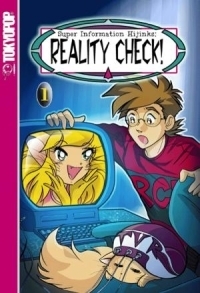
Fair use allows me to use the cover art to this wonderful manga comic Reality Check!
 , however truth in advertising requires I state that this blog post has absolutely nothing to do with this comic. I just needed a catchy graphic that contained the words "Reality Check" -- and this Rikki Simons comic [full title: Super Information Hijinks: Reality Check!] serves that purpose.
, however truth in advertising requires I state that this blog post has absolutely nothing to do with this comic. I just needed a catchy graphic that contained the words "Reality Check" -- and this Rikki Simons comic [full title: Super Information Hijinks: Reality Check!] serves that purpose.My reality check, the one about which I am writing today, has to do with that point in a writer's life when s/he has to come to grips with the manuscript they've been working on for months, possibly even for years.
In mid-2007 when I was acquiring for Golden Gryphon Press, I received a submissions query from a writer who was a fan of "pulp sword & sorcery" fantasy fiction. He explained that since little fiction had been written recently [at the time of this query] in the style of Robert E. Howard and Lin Carter, among others, he had written his own pulp sword & sorcery novel and was seeking publication.
His email was well-written and quite intriguing; he had my attention, so I replied in kind. In his next response, he attached a copy of the full manuscript, but included a caveat:
...the opening couple of chapters are admittedly the weakest portions of my novel, and I am at a loss as to how to improve them, so if you wouldn't mind reading ahead to chapter three or so where the real action begins, I would greatly appreciate it.
Trust me, this is not something I want to hear as an acquiring editor, that the first two chapters of a submission are weak and the author is at a loss on how to fix it. [Maybe just begin the novel with chapter 3 and weave in the necessary back story from chapters 1 and 2 where appropriate?]
So I read the first three chapters; actually, the novel began with a lengthy prologue, too! The overlong, wordy, winding sentences, that seemed to ramble on and on, nearly drove me to drink (well, at least an excessive amount of coffee)... As a test, I rewrote one paragraph (only two sentences!) without all the unnecessary verbiage and reduced it from 84 words to 77 words. Doesn't seem like much but it made a huge difference in the flow of the paragraph. In another scene he introduced five major characters -- plus a demon -- all with names that weren't...well, they weren't as easy to pronounce as "Conan."
So I sent him a response that included quite a bit of feedback: the paragraph example from above, the overwhelming number of characters in the scene from above, a few examples of sentence structure issues (misplaced phrases), grammar errors, etc. I also suggested that he find himself a local writers group, through a bookstore, or library, or college, so that he could obtain feedback from fellow writers. His response to my email was quite cordial [I had also mentioned that I was leaving Golden Gryphon Press at the end of the year] but not what I had expected:
Thanks for taking the time to evaluate my submission, and best of luck to you, as well, in your future endeavors. As for your suggestion to allow my work to be critiqued by some manner of reader group, I will have to pass, as I generally find writers to be a rather pretentious lot, and I have no desire to associate with such. Just so you know, I wrote this novel for my own personal amusement, and only decided to shop it around to publishers at the behest of friends and family. Obviously, based upon your critique of my work, I should just stick to writing for pleasure as I obviously haven't the necessary skills to compete in the professional market nor do I have the drive to make myself more competitive. Lesson learned.
That, boys and girls, is a reality check.
Which brings me to the present: Baycon 2012, held over the Labor Day weekend. I participated on a panel entitled "Self-Publishing: Where Does It Fit in the Literary Food Chain." This was one of those panels that was so well attended, so active a discussion, and so engrossing that I wish we had had at least another hour to continue the dialog; one and a half hours simply wasn't sufficient time.
Every discussion and panel on self-publishing in which I have participated has inevitably covered the subject of editing -- specifically the need to have one's manuscript professionally edited. Too many self-published writers are hoping to be the next Amanda Hocking, and to accomplish this rare feat with little or no out-of-pocket expenses -- like professional editing, professional cover art and design, etc. So when this subject came up during the panel discussion, one of the audience members asked: "Where do we find professional editors?" -- and I blurted out: "You can hire me!"1 In addition to my blurt, the panel covered other ways in which a writer might connect with an appropriate editor.
The convention was still in full swing, when on Sunday I received an email with the subject line: You said, "You can hire me!" One of the audience members at that panel discussion wanted to hire me to edit her manuscript, to which I eventually agreed.
First, however, I wanted to make sure we were compatible, so to speak. I requested the first chapter of her novel, which she sent me; I then did a full developmental edit on it, and provided her feedback via email. There was quite a lot of red ink -- including a suggested title change -- and I wanted to make sure she was open to this degree of feedback. She was.
This individual had been working on this novel for four years. Not full time, of course, as few writers have the luxury of being able to give up their day job. But nevertheless, she had put a lot of time into this manuscript; she had paid one professional author for an overall critique, she had workshopped parts of the novel at a past Worldcon and at a past Baycon, received feedback from writers met during NaNoWriMo, and she had also received feedback from beta readers.
She had been doing everything right [write] so far, at least in my professional opinion, but did she really want to invest further in this manuscript, or was she simply too attached to it to let go, to move on to something else, something new. Few authors write and successfully publish their first novel, even second and third novels. Many writers have one, or two, or even more completed novels stashed away in desk drawers or boxed on shelves in the garage that they don't want to toss away, yet hope no one will ever read them.
I felt the time was right for a reality check. I emailed the author and reiterated much of what she had communicated to me already regarding the novel's history. And then I asked her point blank if she was ready to rework this four-year-old novel yet again? Or, was she simply too attached to it due to personal familial reasons? Would it be more productive to set the novel in a drawer and move on to the next one?
I realized that if she agreed with me, I had just talked myself out of a job -- and income. But I couldn't ignore this concern.
She responded: "Your concerns are fair enough..." She explained that other writers had encouraged her to do something with the novel, specifically to publish it online. She went on to say:
I'd initially had very negative feelings about any kind of self-publishing, but I attended panels at BayCon planning to reconsider the idea within the current environment of online publishing.... However, I would still like anything I make publicly available to be my best effort and as close to professional quality as I can get it.
I had asked the author to rethink this project -- which she did -- and I was satisfied with her response. She is considering publishing the novel for free, online [she could possibly ask for donations were she to release the novel, say, one chapter at a time]. This action, if properly promoted, could develop a reader base, which in turn would be essential to any future self-publishing endeavor. But, bottom line, she insisted on professional editing even though she may be offering the novel to readers for free. That impressed me.
My question to you: Do you need a reality check on your work in progress?
---------------
Footnote:
1. I don't promote myself, per se, on this blog as much as I probably should. So let me take this opportunity to do so: I am an editor, and I am available to work on your manuscript. I can be hired to do developmental editing, line and copy editing, proof reading, or any combination of all three. My availability is determined by my workload at any point in time. Please feel free to contact me about your project and your requirements, and my rates. If you "View my complete profile" on Blogger you will find a link to my email address. And here are my professional references.

Published on June 17, 2012 19:46
June 6, 2012
Ray Bradbury....
In my month end Links & Things post for April 2009, I included the following entry on Ray Bradbury:
The link above is to a brief article in the Los Angeles Times and well worth your time (no pun intended) -- and includes a photo of ole Ray signing books at the LA Festival of Books. His appearance there will be sorely missed.
Speaking of Ray's love of the printed word, and the joy he took in signing copies of his books and stories, I thought I would include one such book in my library that I personally had Ray Bradbury sign many years ago:
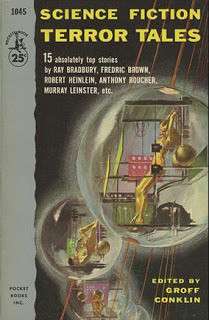
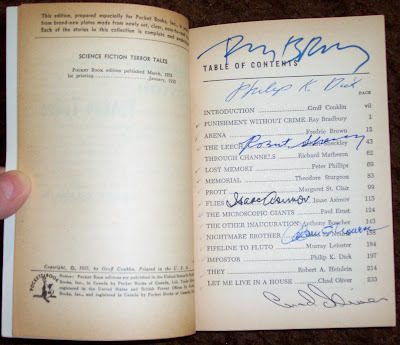
You'll have to pardon the inclusion of my thumb in the photo, but the book is too fragile (the binding glue is completely dried out) to lay flat. The signatures, from top to bottom: Ray Bradbury, Philip K. Dick, Robert Sheckley, Isaac Asimov, Alan E. Nourse, and Chad Oliver -- all past masters, all of them now gone.
There are far more knowledgeable and eloquent tributes to Mr. Bradbury across the web today -- particularly this one from the LA Times, which includes twenty-one photos of Bradbury from throughout his life, beginning at age 3. But I just wanted to acknowledge his passing with this very brief post.
Ray Bradbury
(August 22, 1920 – June 5, 2012)


Ray Bradbury, during his regular appearance at the Los Angeles Festival of Books, remarked that this may be his final appearance unless the LA Times resurrects its "Book" section, which, like most of the paper, has seen staff and page counts cut over the years. Bradbury worked for the LA Times "Book" section more than forty years ago! He shares some anecdotes in this article, including how he typed the manuscript for Fahrenheit 451 using a "pay" typewriter in a basement room under the Powell Library on the UCLA campus. The typewriter required 10 cents for 30 minutes. Bradbury came each day with a bag of dimes. When the manuscript was complete, he had spent $9.80. (via @GalleyCat) [Good luck, Ray, on getting the "Book" section reinstated!]
The link above is to a brief article in the Los Angeles Times and well worth your time (no pun intended) -- and includes a photo of ole Ray signing books at the LA Festival of Books. His appearance there will be sorely missed.
Speaking of Ray's love of the printed word, and the joy he took in signing copies of his books and stories, I thought I would include one such book in my library that I personally had Ray Bradbury sign many years ago:


You'll have to pardon the inclusion of my thumb in the photo, but the book is too fragile (the binding glue is completely dried out) to lay flat. The signatures, from top to bottom: Ray Bradbury, Philip K. Dick, Robert Sheckley, Isaac Asimov, Alan E. Nourse, and Chad Oliver -- all past masters, all of them now gone.
There are far more knowledgeable and eloquent tributes to Mr. Bradbury across the web today -- particularly this one from the LA Times, which includes twenty-one photos of Bradbury from throughout his life, beginning at age 3. But I just wanted to acknowledge his passing with this very brief post.
Ray Bradbury
(August 22, 1920 – June 5, 2012)

Published on June 06, 2012 10:50
June 5, 2012
May Links & Things
This is my monthly wrap-up of May's Links & Things. You can receive these links in real time by following me on Twitter: @martyhalpern; or Friending me on Facebook (FB). Note, however, that not all of my tweeted/FB links make it into these month-end posts. May was another busy month, so there is a lot of content here. Previous monthly recaps are accessible via the "Links and Things" tag in the right column. What would the publishing world be without another "authors beware" entry.... In this case I'm referring to Open Casket Press, Living Dead Press, and Undead Press. Don't be fooled: these three presses are all run by the same individual: Anthony Giangregorio -- and when "Tony" mentions his "editor" (Vincenzo Bilof) he's also talking about himself, though he wants you to believe that he is referring to some other nebulous individual. New author Mandy DeGeit was excited to have her first published story accepted for an Undead Press anthology -- that is, until she discovered after the story was published how the "editor" had rewritten her work, going so far as to include a paragraph of a dog beating (and sexual arousal) that was never in the original story. Mandy's sad tale went viral shortly thereafter, and when Richard Salter read it, he decided to go public as to why he pulled his novel, World's Collider, from Open Casket Press. You can read Richard's blog post, which also contains a link to Mandy's blog post. Bottom line: Stay away from Open Casket/Living Dead/Undead Press and Anthony "Tony" Giangregorio/Vincenzo Bilof. You have been duly warned.
But I'm not quite finished with Tony Giangregorio. Author Adam-Troy Castro posted a lengthy Facebook piece concerning this individual; since only FB users could read said post, I asked Adam to repost it elsewhere, and he graciously complied. So now non-FB users can read his "Secret Sequels" post. Here's a quote: "What Giangregorio has done is specifically, and deliberately, hijack the name of a better work and superior work to his sequel; he is specifically saying, 'This is a sequel to Dawn of the Dead.' Which he has no right to do."
I spent Memorial Day weekend at the annual BayCon convention here in Santa Clara County. One of the many panels in which I participated was entitled "Editors, Agents and Other Endangered Species"; the moderator, Dario Ciriello, posted a recap of the panel, with particular emphasis on the "editors" part.
Hugh Howey. Recognize that name? If not, neither had I, until May 14 when I read in Publishers Weekly online that film rights to his science fiction series Wool had sold to 20th Century Fox -- and partnering with Fox on the film deal is Scott Free, none other than Ridley and Tony Scott's production company. So I purchased a copy of Wool myself, and in the process learned that Hugh Howey had originally self-published Wool as a series of five novellas. The book will be published in hardcover in the UK, and the author is currently at work on a prequel series. If you search out Wool you will read nothing but rave reviews of this book. It represents one of the true self-publishing success stories, the result of a great story and great writing, and hard work. Howey's guest blog on IndieReader provides some personal history on Wool and how the movie rights came about. And he even writes on his own blog about receiving payment from a reader who originally obtained a copy of his book for free from a pirate site. As Howey writes: "How cool an exchange is that?"
had sold to 20th Century Fox -- and partnering with Fox on the film deal is Scott Free, none other than Ridley and Tony Scott's production company. So I purchased a copy of Wool myself, and in the process learned that Hugh Howey had originally self-published Wool as a series of five novellas. The book will be published in hardcover in the UK, and the author is currently at work on a prequel series. If you search out Wool you will read nothing but rave reviews of this book. It represents one of the true self-publishing success stories, the result of a great story and great writing, and hard work. Howey's guest blog on IndieReader provides some personal history on Wool and how the movie rights came about. And he even writes on his own blog about receiving payment from a reader who originally obtained a copy of his book for free from a pirate site. As Howey writes: "How cool an exchange is that?"
Self-publishing is, of course, what everyone is talking about, especially when you read success stories like Hugh Howey's above. Rudy Rucker (@rudytheelder) has posted a four-part series on his step-by-step road to creating an ebook, which includes working with HTML code and apps like Calibre and Sigil. Begin at part one: "Getting Started," and you'll find links at the top of each page to get you to parts 2, 3, and 4. In part 4, you can even purchase the ebook edition of Rudy's How to Make an Ebook for only $1.95 from his own Transreal Books press.
Catherine Ryan Howard (@cathryanhoward) has a bit of a reality check for authors before they dive into self-publishing, with a blog post entitled "How To Sell Self-Published Books: Read This First." Catherine delves into five points: 1) By Default, No One Cares About Your Book; 2) Your Book is a Product—and It Had Better Work; 3) Social Media is About Connection; 4) You Can’t Sell New Concepts with Old Ways; and [my favorite] 5) You Are Not The Next Amanda Hocking. And be sure to check out the more than 240 Comments, too. (via Jane Friedman’s FB page)
But once you have that self-published book, how do you sell it beyond your immediate family and close friends? Mediabistro.com's GalleyCat (@galleycat) -- a website that every author should subscribe to! -- links to an article from the American Booksellers Association (ABA) on how self-published authors can sell their books at a few independent bookstores. And then GalleyCat takes it one step further by listing a few additional bookstores that will sell self-published titles.
Traditional publishers have their name as their brand; but what about self-published/independent authors? The UK's Guardian online, on its Book Blog, has an article on author collectives, entitled "Author collectives signal a new chapter for self-publishing." The opening paragraph reads: "With online groups working to sift out the hidden gems, and a New York co-operative instituting a 'seal of quality,' is the world of independent publishing finally getting organised?" (via @thecreativepenn via @dirtywhitecandy)
We all have experienced the "time suck" that social media presents; I mean, just look at these Links & Things blog posts I do each month! On The Creative Penn blog, guest blogger J. Steve Miller explains why he has given up trying to attract social media followers, and concentrates on other ways of promoting his book. He divides his post into two parts: 1) Problems with Building a Social Media Following; and 2) How I Use Social Media. And, there are more than 50 Comments, too. (via @thecreativepenn)
This is another site that every author -- especially bloggers -- should be subscribed to: Copyblogger -- and the post I wish to bring your attention to is Sonia Simone's "The 7 Bad Habits of Insanely Productive People": Bad Habit #1) Being thin-skinned; #2) Flakiness; #3) Selfishness; #4) Greed; #5) Distractibility; #6) Self-doubt; and #7) Arrogance. With more than 130 Comments as well. (via @RachelleGardner)
For the past three years at BayCon, I have participated in the Iron Editors panel. Attendees turn in one or two pages of writing, and the panel of authors and editors gets to critique them -- up close and personal in front of the entire audience. In this year's panel, the subject of "names" came up. My response was that if I have to spend time trying to figure out how to pronounce the names in a story, I will simply find another story to read. I never have a shortage of backlogged stories/novels. However, the information conveyed in the selection of a name must also be considered. Juliette Wade (@JulietteWade) has a blog post entitled "Manipulating the Feeling Conveyed by Character Names." Juliette writes: "Fantasy and science fiction often involves making up names. This can be fun and challenging in its own way - and also full of potential pitfalls. Each time you make up a name, it's important to consider not only the onomatopoetic feel of 'bright' or 'dark' consonants and vowels, for example, but also the different similar words that will be evoked by the name."
Getting into more profound thinking is Charles Stross's (@cstross) essay, which appears on Charlie's Diary, entitled "SF, big ideas, ideology: what is to be done?" Here's an excerpt: "In fact, those people who are doing the 'big visionary ideas about the future' SF are mostly doing so in a vacuum of critical appreciation.... And there, over in a corner, is Bruce Sterling, blazing a lonely pioneering trail into the future. Chairman Bruce played out cyberpunk before most of us ever heard of it, invented the New Space Opera in Schismatrix (which looked as if nobody appreciated it for a couple of decades), co-wrote the most interesting hard-SF steampunk novel of all, and got into global climate change in the early '90s. He's currently about ten years ahead of the curve. If SF was about big innovative visions, he'd need to build an extension to house all his Hugo awards... So what's at the root of this problem? Why are the innovative and rigorously extrapolated visions of the future so thin on the ground and so comprehensively ignored?" And prepare yourself for the more than 600 Comments! (via @catvalente)
Speaking of big ideas, culture -- and inventions, The Atlantic 's technology section contains a piece by Suzanne Fischer entitled "Do Our Values Shape Our Inventions, or Do Our Inventions Shape Us?": "Imagining a futuristic world can help us tease out the relationship between culture and technology." Unfortunately, the article refers to "sf" as "speculative fiction" even though hard science fiction writer Karl Schroeder is specifically mentioned. You'll never read the words "science fiction" in The Atlantic! (via Dario Cariello's Facebook page)
Pamela Sargent, in a post on her FB page, pointed me to a three-part series in The New York Times online on Philip K. Dick, entitled "The Sci-Fi Philosopher." From the article: "On Feb. 20, 1974, Dick was hit with the force of an extraordinary revelation after a visit to the dentist for an impacted wisdom tooth for which he had received a dose of sodium pentothal. A young woman delivered a bottle of Darvon tablets to his apartment in Fullerton, Calif. She was wearing a necklace with the pendant of a golden fish, an ancient Christian symbol that had been adopted by the Jesus counterculture movement of the late 1960s. The fish pendant, on Dick's [written] account, began to emit a golden ray of light, and Dick suddenly experienced what he called, with a nod to Plato, anamnesis: the recollection or total recall of the entire sum of knowledge."
Do we have time for one more internet meltdown? Here's another author/publisher rant and rave that went viral. But first, let me preface this with a comment: If you write a book -- and the book is then published by a publishing company/press that you, the author, have created for the sole purpose of publishing said book -- then by definition: you are a self-published author and the book is a self-published book. Author, and publisher, M. R. Mathias, posting with much vehemence on the Fantasy Faction website forums, insisted that he is not a self-published author (but only because he has published a lot of books and won a lot of awards). Fantasy Faction recaps the entire episode with a blog post entitled "The Man Who Thought He Was King." [Note to authors: Do not do this!]


But I'm not quite finished with Tony Giangregorio. Author Adam-Troy Castro posted a lengthy Facebook piece concerning this individual; since only FB users could read said post, I asked Adam to repost it elsewhere, and he graciously complied. So now non-FB users can read his "Secret Sequels" post. Here's a quote: "What Giangregorio has done is specifically, and deliberately, hijack the name of a better work and superior work to his sequel; he is specifically saying, 'This is a sequel to Dawn of the Dead.' Which he has no right to do."
I spent Memorial Day weekend at the annual BayCon convention here in Santa Clara County. One of the many panels in which I participated was entitled "Editors, Agents and Other Endangered Species"; the moderator, Dario Ciriello, posted a recap of the panel, with particular emphasis on the "editors" part.
Hugh Howey. Recognize that name? If not, neither had I, until May 14 when I read in Publishers Weekly online that film rights to his science fiction series Wool
 had sold to 20th Century Fox -- and partnering with Fox on the film deal is Scott Free, none other than Ridley and Tony Scott's production company. So I purchased a copy of Wool myself, and in the process learned that Hugh Howey had originally self-published Wool as a series of five novellas. The book will be published in hardcover in the UK, and the author is currently at work on a prequel series. If you search out Wool you will read nothing but rave reviews of this book. It represents one of the true self-publishing success stories, the result of a great story and great writing, and hard work. Howey's guest blog on IndieReader provides some personal history on Wool and how the movie rights came about. And he even writes on his own blog about receiving payment from a reader who originally obtained a copy of his book for free from a pirate site. As Howey writes: "How cool an exchange is that?"
had sold to 20th Century Fox -- and partnering with Fox on the film deal is Scott Free, none other than Ridley and Tony Scott's production company. So I purchased a copy of Wool myself, and in the process learned that Hugh Howey had originally self-published Wool as a series of five novellas. The book will be published in hardcover in the UK, and the author is currently at work on a prequel series. If you search out Wool you will read nothing but rave reviews of this book. It represents one of the true self-publishing success stories, the result of a great story and great writing, and hard work. Howey's guest blog on IndieReader provides some personal history on Wool and how the movie rights came about. And he even writes on his own blog about receiving payment from a reader who originally obtained a copy of his book for free from a pirate site. As Howey writes: "How cool an exchange is that?"Self-publishing is, of course, what everyone is talking about, especially when you read success stories like Hugh Howey's above. Rudy Rucker (@rudytheelder) has posted a four-part series on his step-by-step road to creating an ebook, which includes working with HTML code and apps like Calibre and Sigil. Begin at part one: "Getting Started," and you'll find links at the top of each page to get you to parts 2, 3, and 4. In part 4, you can even purchase the ebook edition of Rudy's How to Make an Ebook for only $1.95 from his own Transreal Books press.
Catherine Ryan Howard (@cathryanhoward) has a bit of a reality check for authors before they dive into self-publishing, with a blog post entitled "How To Sell Self-Published Books: Read This First." Catherine delves into five points: 1) By Default, No One Cares About Your Book; 2) Your Book is a Product—and It Had Better Work; 3) Social Media is About Connection; 4) You Can’t Sell New Concepts with Old Ways; and [my favorite] 5) You Are Not The Next Amanda Hocking. And be sure to check out the more than 240 Comments, too. (via Jane Friedman’s FB page)
But once you have that self-published book, how do you sell it beyond your immediate family and close friends? Mediabistro.com's GalleyCat (@galleycat) -- a website that every author should subscribe to! -- links to an article from the American Booksellers Association (ABA) on how self-published authors can sell their books at a few independent bookstores. And then GalleyCat takes it one step further by listing a few additional bookstores that will sell self-published titles.
Traditional publishers have their name as their brand; but what about self-published/independent authors? The UK's Guardian online, on its Book Blog, has an article on author collectives, entitled "Author collectives signal a new chapter for self-publishing." The opening paragraph reads: "With online groups working to sift out the hidden gems, and a New York co-operative instituting a 'seal of quality,' is the world of independent publishing finally getting organised?" (via @thecreativepenn via @dirtywhitecandy)
We all have experienced the "time suck" that social media presents; I mean, just look at these Links & Things blog posts I do each month! On The Creative Penn blog, guest blogger J. Steve Miller explains why he has given up trying to attract social media followers, and concentrates on other ways of promoting his book. He divides his post into two parts: 1) Problems with Building a Social Media Following; and 2) How I Use Social Media. And, there are more than 50 Comments, too. (via @thecreativepenn)
This is another site that every author -- especially bloggers -- should be subscribed to: Copyblogger -- and the post I wish to bring your attention to is Sonia Simone's "The 7 Bad Habits of Insanely Productive People": Bad Habit #1) Being thin-skinned; #2) Flakiness; #3) Selfishness; #4) Greed; #5) Distractibility; #6) Self-doubt; and #7) Arrogance. With more than 130 Comments as well. (via @RachelleGardner)
For the past three years at BayCon, I have participated in the Iron Editors panel. Attendees turn in one or two pages of writing, and the panel of authors and editors gets to critique them -- up close and personal in front of the entire audience. In this year's panel, the subject of "names" came up. My response was that if I have to spend time trying to figure out how to pronounce the names in a story, I will simply find another story to read. I never have a shortage of backlogged stories/novels. However, the information conveyed in the selection of a name must also be considered. Juliette Wade (@JulietteWade) has a blog post entitled "Manipulating the Feeling Conveyed by Character Names." Juliette writes: "Fantasy and science fiction often involves making up names. This can be fun and challenging in its own way - and also full of potential pitfalls. Each time you make up a name, it's important to consider not only the onomatopoetic feel of 'bright' or 'dark' consonants and vowels, for example, but also the different similar words that will be evoked by the name."
Getting into more profound thinking is Charles Stross's (@cstross) essay, which appears on Charlie's Diary, entitled "SF, big ideas, ideology: what is to be done?" Here's an excerpt: "In fact, those people who are doing the 'big visionary ideas about the future' SF are mostly doing so in a vacuum of critical appreciation.... And there, over in a corner, is Bruce Sterling, blazing a lonely pioneering trail into the future. Chairman Bruce played out cyberpunk before most of us ever heard of it, invented the New Space Opera in Schismatrix (which looked as if nobody appreciated it for a couple of decades), co-wrote the most interesting hard-SF steampunk novel of all, and got into global climate change in the early '90s. He's currently about ten years ahead of the curve. If SF was about big innovative visions, he'd need to build an extension to house all his Hugo awards... So what's at the root of this problem? Why are the innovative and rigorously extrapolated visions of the future so thin on the ground and so comprehensively ignored?" And prepare yourself for the more than 600 Comments! (via @catvalente)
Speaking of big ideas, culture -- and inventions, The Atlantic 's technology section contains a piece by Suzanne Fischer entitled "Do Our Values Shape Our Inventions, or Do Our Inventions Shape Us?": "Imagining a futuristic world can help us tease out the relationship between culture and technology." Unfortunately, the article refers to "sf" as "speculative fiction" even though hard science fiction writer Karl Schroeder is specifically mentioned. You'll never read the words "science fiction" in The Atlantic! (via Dario Cariello's Facebook page)
Pamela Sargent, in a post on her FB page, pointed me to a three-part series in The New York Times online on Philip K. Dick, entitled "The Sci-Fi Philosopher." From the article: "On Feb. 20, 1974, Dick was hit with the force of an extraordinary revelation after a visit to the dentist for an impacted wisdom tooth for which he had received a dose of sodium pentothal. A young woman delivered a bottle of Darvon tablets to his apartment in Fullerton, Calif. She was wearing a necklace with the pendant of a golden fish, an ancient Christian symbol that had been adopted by the Jesus counterculture movement of the late 1960s. The fish pendant, on Dick's [written] account, began to emit a golden ray of light, and Dick suddenly experienced what he called, with a nod to Plato, anamnesis: the recollection or total recall of the entire sum of knowledge."
Do we have time for one more internet meltdown? Here's another author/publisher rant and rave that went viral. But first, let me preface this with a comment: If you write a book -- and the book is then published by a publishing company/press that you, the author, have created for the sole purpose of publishing said book -- then by definition: you are a self-published author and the book is a self-published book. Author, and publisher, M. R. Mathias, posting with much vehemence on the Fantasy Faction website forums, insisted that he is not a self-published author (but only because he has published a lot of books and won a lot of awards). Fantasy Faction recaps the entire episode with a blog post entitled "The Man Who Thought He Was King." [Note to authors: Do not do this!]

Published on June 05, 2012 17:20
June 1, 2012
To Every Thing There Is a Season....
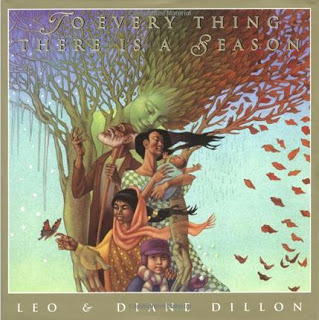
On Saturday, July 1, 1989, I drove nearly 400 miles -- with my wife and young daughter in tow -- in order to meet Leo and Diane Dillon. They were appearing that weekend at Westercon 42, at the Anaheim Marriott Hotel.
The Dillons weren't the artist guests of honor, but somehow I had learned they would be in attendance at the convention. (Remember, there was no online "social media" then like there is now.) According to Tom Whitmore [more on Tom in a bit], the Dillons tended to turn down GOH invites, but they were in the middle of a book tour, and managed to squeeze in some convention time into their hectic schedule. Regardless of how I heard the Dillons were planning to be at the convention, I was planning to be there, too.
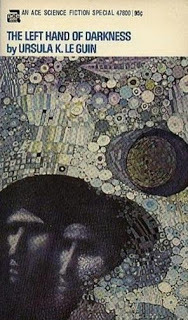
Nebula and Hugo awards for Best Novel
Upon arriving in Anaheim on Saturday, July 1, we stayed at my parents' house [the house, alas, that I finally sold in April] as they lived only a mile or so from the hotel. And while my wife and daughter spent time that weekend with my family, I made my way to the Marriott and Westercon 42.
In addition to my family and a couple pieces of luggage, I had also brought with me two fairly large boxes (printer paper boxes) of books that I had hoped to have Leo and Diane Dillon sign. Among the approximately 50 or so books were all 36 original Ace Science Fiction Specials, edited by the late Terry Carr, in which the Dillons had done the cover art.1 Obviously this was back in the days of my book collecting mania. I still have these books -- and probably about three thousand more -- I just don't worry about getting them signed any longer. (That is, unless the book is one that I edited and/or the author is a personal friend.)
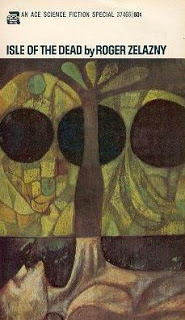 To successfully get all of my books signed, I needed some dedicated time with the Dillons. So, I approached Tom Whitmore, who was on the Westercon 42 staff, and asked for his assistance. Tom was one of the three founding partners of the Other Change of Hobbit bookstore in Berkeley; I knew Tom from spending far too much time (and undoubtedly far too much money) at that particular bookstore during the mid-to-late '80s and '90s.
To successfully get all of my books signed, I needed some dedicated time with the Dillons. So, I approached Tom Whitmore, who was on the Westercon 42 staff, and asked for his assistance. Tom was one of the three founding partners of the Other Change of Hobbit bookstore in Berkeley; I knew Tom from spending far too much time (and undoubtedly far too much money) at that particular bookstore during the mid-to-late '80s and '90s.Leo and Diane Dillon were presenting a slide show of their work in the afternoon, I believe it was on Sunday, July 2; following the slide show presentation, Tom graciously escorted the Dillons and me to a smaller room where we could have some private time -- and, in fact, Tom even remained by the door to ensure we were not interrupted.
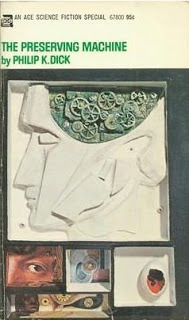 But before all the signing was the Dillons' slide show presentation. I have this vague (after 23 years!) memory of the event, and truly wish that a recording of the Dillons' commentary was available. They showed slide after slide, discussing the particular technique used with each one: wood block prints, batik (or some similar process), various mixed media; and the occasional hassles they had with art directors, deadlines, and such. How Leo fell asleep while painting late one night and Diane picked up right where he had left off... How each piece they did was a collaboration of ideas and skills: what they themselves referred to as the "Third Artist." They touched on -- but didn't dwell upon -- some of the difficulties they encountered in the late '50s and '60s as an interracial couple.
But before all the signing was the Dillons' slide show presentation. I have this vague (after 23 years!) memory of the event, and truly wish that a recording of the Dillons' commentary was available. They showed slide after slide, discussing the particular technique used with each one: wood block prints, batik (or some similar process), various mixed media; and the occasional hassles they had with art directors, deadlines, and such. How Leo fell asleep while painting late one night and Diane picked up right where he had left off... How each piece they did was a collaboration of ideas and skills: what they themselves referred to as the "Third Artist." They touched on -- but didn't dwell upon -- some of the difficulties they encountered in the late '50s and '60s as an interracial couple. Tom Whitmore also reminded me that it was this slide show that the Dillons presented an unfinished cover for The Last Unicorn. I don't recall the full story (i.e. how the cover came to be, and then remained unfinished), but Tom informed Connor Freff Cochran -- Peter S. Beagle's agent, co-producer, publisher, etc. -- about the unfinished piece; Connor then contacted the Dillons and had them finish the piece for a reprint edition of the book.
 Sadly, I don't have Marilu Henner's memory, so I can't recall the specific details, but I can recall the feeling I experienced as Leo and Diane Dillon brought each of those pieces of art to life with their words.
Sadly, I don't have Marilu Henner's memory, so I can't recall the specific details, but I can recall the feeling I experienced as Leo and Diane Dillon brought each of those pieces of art to life with their words.For the signing afterward, we were all seated in a meeting room with a central table. I would open each book to the title page and then slide it across to Diane; she would sign her name, followed by a slash, and then pass the book along to Leo; he, in turn, would sign his name on the other side of the slash, thusly:

Even with 50 books, this whole process shouldn't have taken longer than, say, fifteen minutes at most. But as I would hand Diane one of the Ace SF Specials, she would say something like, I haven't seen this cover in 15 years! -- and then proceed to show it to Leo, and then they would chat about some unique aspect of that particular cover. I was experiencing Leo and Diane Dillon art history first hand, and I still didn't have a tape recorder. Somewhere around 45 minutes later, we said our goodbyes and parted company.
This, of course, all came back to me this week when I read of the passing of Leo Dillon on May 26.
So I would like to take this opportunity to thank Leo and Diane Dillon for sharing a piece of their life with me that day, and especially for their graciousness and patience. I met them again, albeit briefly, ten years later when they were, in fact, guests of honor at the 25th World Fantasy Convention in Providence, Rhode Island. This time I traveled approximately 3,000 miles -- but only had them sign one book: To Every Thing There Is a Season (pictured above).
Lastly, I want to thank Tom Whitmore for his friendship back in the day, and for helping to refresh my memory this day.
---------------
Footnote:
1. There were 38 original Ace Science Fiction Specials plus 1 reprint of an earlier title (Alexi Panshin's Rite of Passage): 36 with cover art by Leo and Diane Dillon, and 3 with cover art by Davis Meltzer. I also had documentation on 4 additional Ace paperbacks that had been selected by Terry Carr as Ace SF Specials, but the series was cancelled before these 4 books were released. One of these, Brian Aldiss's Barefoot in the Head, also had cover art by the Dillons. (Meltzer did the cover art for the other 3 titles.) The 36 titles I had the Dillons sign included the Aldiss extra, but did not include the 1 reprint title. I had the book, but didn't have it with me at the time of the signing. For those into books and lists and such, here are the 36 Ace SF Specials that I had the Dillons sign:
James H. Schmitz - The Witches of Karres (1968, A-13)
Alexei Panshin - Rite of Passage (1968, A-16)
Piers Anthony and Robert E. Margroff - The Ring (1968, A-19)
James Blish and Norman L. Knight - A Torrent of Faces (1968, A-29)
Clifford D. Simak - Why Call Them Back from Heaven? (1968, H-42)
R. A. Lafferty - Past Master (1968, H-54)
Gertrude Friedberg - The Revolving Boy (1968, H-58)
Wilson Tucker - The Lincoln Hunters (1968, H-62)
Joanna Russ - Picnic on Paradise (1968, H-72)
Bob Shaw - The Two-Timers (1968, H-79)
D. G. Compton - Synthajoy (1968, H-86)
James H. Schmitz - The Demon Breed (1968, H-105)
Michael Moorcock - The Black Corridor (1969, 06530)
R. A. Lafferty - Fourth Mansions (1969, 24590)
Avram Davidson - The Island Under the Earth (1969, 37425)
Roger Zelazny - Isle of the Dead (1969, 37465)
John Brunner - The Jagged Orbit (1969, 38120)
Ursula K. Le Guin - The Left Hand of Darkness (1969, 47800)
Bob Shaw - The Palace of Eternity (1969, 65050)
Keith Roberts - Pavane (1969, 65430)
Philip K. Dick - The Preserving Machine (1969, 67800)
John T. Sladek - Mechasm (1969, 71435)
D. G. Compton - The Silent Multitude (1969, 76385)
Ron Goulart - After Things Fell Apart (1970, 00950)
Joanna Russ - And Chaos Died (1970, 02268)
D. G. Compton - Chronocules (1970, 10480)
R. A. Lafferty - Nine Hundred Grandmothers (1970, 58050)
Bob Shaw - One Million Tomorrows (1970, 62938)
Avram Davidson - The Phoenix and the Mirror (1970, 66100)
D. G. Compton - The Steel Crocodile (1970, 78575)
Ursula K. Le Guin - A Wizard of Earthsea (1970, 90075)
Wilson Tucker - The Year of the Quiet Sun (1970, 94200)
Gordon Eklund - The Eclipse of Dawn (1971, 18630)
Suzette Haden Elgin - Furthest (1971, 25950)
John Brunner - The Traveler in Black (1971, 82210)
Brian W. Aldiss - Barefoot in the Head (1972, 04758)

Published on June 01, 2012 17:20
May 24, 2012
Tachyons Proven To No Longer Be Imaginary
According to Wikipedia:
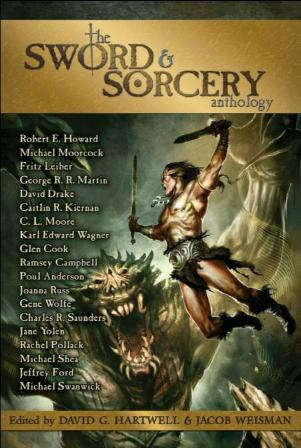 This past week I visited the newly remodeled and greatly enlarged office of Tachyon Publications in San Francisco. Of course, the remodeled office was only new to me as I haven't visited in the past year due to familial issues, now resolved, which I previously blogged about. But my lateness doesn't detract from the beauty of the new office: the bay windows, the wood flooring, the unique cinder block walls toward the back half of the office space, the openness -- and the fact that the rear two-thirds of the office is tunneled into the side of a hill (thus the cinder blocks)!
This past week I visited the newly remodeled and greatly enlarged office of Tachyon Publications in San Francisco. Of course, the remodeled office was only new to me as I haven't visited in the past year due to familial issues, now resolved, which I previously blogged about. But my lateness doesn't detract from the beauty of the new office: the bay windows, the wood flooring, the unique cinder block walls toward the back half of the office space, the openness -- and the fact that the rear two-thirds of the office is tunneled into the side of a hill (thus the cinder blocks)!
I detest driving in the city of San Francisco, so I have to rely on public transportation. This means I take the CalTrain commuter from the San Jose station to the San Francisco 22nd Street station, whereupon I am then chauffeured to the office in the Tachyonmobile. Unlike tachyons, though, CalTrain does not move at superluminal speed. In fact, the trip each way takes approximately one and a half hours, with a myriad of mind-numbing stops in between. But before one can even consider boarding a train at the San Jose station, one must first find a parking space! I circled all three parking lots, and then re-circled the last parking lot to its very edges and found what I still believe to be the very last available slot in all of stationdom. Then, once a parking spot is found, one must pay tribute to the god of parking.
I was graciously met at the 22nd Street station by Jacob Weisman, editor and publisher, and Jill Roberts, managing editor. I communicate with Jill regularly via email, and Jacob and I chat occasionally on the telephone, so an opportunity to get together -- and also share a lunchtime meal -- is always welcome.
The day prior to my visit, cases of Tachyon's newest book, The Sword & Sorcery Anthology , edited by David G. Hartwell and Jacob Weisman, had arrived at the office; following our lunch, Jacob dutifully packed up review copies and comp copies, later to be shipped out. In fact, since I had worked on this book as well, I was able to take a couple comp copies home with me, thus saving Jacob a wee bit of packing time and postage.
, edited by David G. Hartwell and Jacob Weisman, had arrived at the office; following our lunch, Jacob dutifully packed up review copies and comp copies, later to be shipped out. In fact, since I had worked on this book as well, I was able to take a couple comp copies home with me, thus saving Jacob a wee bit of packing time and postage.

I took this first photograph with the front of the office (street side) to my back. Jill is pictured here, diligently working at her desk (or, at least, attempting to look busy) amidst all my chatter and picture-taking. You'll note the step along the floor in the far right portion of the photo. This marks the start of the back two-thirds of the office space -- the darker portion -- wherein the room is tunnelled into the hillside. If you follow along the wall past Jill's desk, you will see where the gray cinder blocks begin as well.

This second, and final, photograph was taken from atop that step and aiming ye olde camera toward the front of the office. That incredibly bright glare at the back of the photo is actually the front bay windows, as they appear on a typical sunny San Francisco day. Pictured to the left in the photograph is Elizabeth Story, associate editor responsible for layout and covers; Jill is to the far right; and editor and publisher Jacob Weisman is to the far left. The white door immediately behind Jacob leads to the entrance way, and the front door. Not pictured here, unfortunately, is Rachel Fagundes, Tachyon intern, who was seated at her desk to my immediate left and thus didn't appear in the photo. [Sorry, Rachel!]
Note: I didn't take any close-ups of the staff. I'm personally not fond of having my picture taken, so I simply assume everyone else feels the same way and I act accordingly.
As I said, I joined Jacob and Jill for lunch, and we had a pleasant chat, mostly biz-related, over sandwiches and pasta -- during which time I learned the secret to having one's book accepted by Tachyon Publications. But even were you to prove that a tachyon does not violate causality, thus rendering the Grandfather Paradox null and void, I still would never utter this secret revealed to me during this otherwise uneventful lunch.
At about 2:45pm, Rina Weisman (also not pictured) left the house with Clyde the cat (at least I assume that was Clyde pitifully meowing in his carrier), on their way to the vet -- with me in tow, on my way back to the train station. Rina, by the way, runs the popular SF in SF reading series and movie nights, which I have had the occasional opportunity to partake in.
The return CalTrain trip to San Jose was just as boring as the earlier trip that day, albeit a lot noisier what with all the students on the train returning home from various schools. I arrived home just after 5:00pm, but that wasn't quite the end of my day. After emptying my briefcase I immediately got back to work on my current project: proof reading and copyediting anthology EPIC (in caps!), edited by John Joseph Adams, and forthcoming from Tachyon Publications later this year.
(in caps!), edited by John Joseph Adams, and forthcoming from Tachyon Publications later this year.


A tachyon is a hypothetical particle that always moves faster than light. Most physicists think that such particles cannot exist because they are not consistent with the known laws of physics....Today, "tachyon" often refers instead to imaginary mass fields, which cannot exceed the speed of light and have come to play an important role in modern physics.
 This past week I visited the newly remodeled and greatly enlarged office of Tachyon Publications in San Francisco. Of course, the remodeled office was only new to me as I haven't visited in the past year due to familial issues, now resolved, which I previously blogged about. But my lateness doesn't detract from the beauty of the new office: the bay windows, the wood flooring, the unique cinder block walls toward the back half of the office space, the openness -- and the fact that the rear two-thirds of the office is tunneled into the side of a hill (thus the cinder blocks)!
This past week I visited the newly remodeled and greatly enlarged office of Tachyon Publications in San Francisco. Of course, the remodeled office was only new to me as I haven't visited in the past year due to familial issues, now resolved, which I previously blogged about. But my lateness doesn't detract from the beauty of the new office: the bay windows, the wood flooring, the unique cinder block walls toward the back half of the office space, the openness -- and the fact that the rear two-thirds of the office is tunneled into the side of a hill (thus the cinder blocks)!I detest driving in the city of San Francisco, so I have to rely on public transportation. This means I take the CalTrain commuter from the San Jose station to the San Francisco 22nd Street station, whereupon I am then chauffeured to the office in the Tachyonmobile. Unlike tachyons, though, CalTrain does not move at superluminal speed. In fact, the trip each way takes approximately one and a half hours, with a myriad of mind-numbing stops in between. But before one can even consider boarding a train at the San Jose station, one must first find a parking space! I circled all three parking lots, and then re-circled the last parking lot to its very edges and found what I still believe to be the very last available slot in all of stationdom. Then, once a parking spot is found, one must pay tribute to the god of parking.
I was graciously met at the 22nd Street station by Jacob Weisman, editor and publisher, and Jill Roberts, managing editor. I communicate with Jill regularly via email, and Jacob and I chat occasionally on the telephone, so an opportunity to get together -- and also share a lunchtime meal -- is always welcome.
The day prior to my visit, cases of Tachyon's newest book, The Sword & Sorcery Anthology
 , edited by David G. Hartwell and Jacob Weisman, had arrived at the office; following our lunch, Jacob dutifully packed up review copies and comp copies, later to be shipped out. In fact, since I had worked on this book as well, I was able to take a couple comp copies home with me, thus saving Jacob a wee bit of packing time and postage.
, edited by David G. Hartwell and Jacob Weisman, had arrived at the office; following our lunch, Jacob dutifully packed up review copies and comp copies, later to be shipped out. In fact, since I had worked on this book as well, I was able to take a couple comp copies home with me, thus saving Jacob a wee bit of packing time and postage.
I took this first photograph with the front of the office (street side) to my back. Jill is pictured here, diligently working at her desk (or, at least, attempting to look busy) amidst all my chatter and picture-taking. You'll note the step along the floor in the far right portion of the photo. This marks the start of the back two-thirds of the office space -- the darker portion -- wherein the room is tunnelled into the hillside. If you follow along the wall past Jill's desk, you will see where the gray cinder blocks begin as well.

This second, and final, photograph was taken from atop that step and aiming ye olde camera toward the front of the office. That incredibly bright glare at the back of the photo is actually the front bay windows, as they appear on a typical sunny San Francisco day. Pictured to the left in the photograph is Elizabeth Story, associate editor responsible for layout and covers; Jill is to the far right; and editor and publisher Jacob Weisman is to the far left. The white door immediately behind Jacob leads to the entrance way, and the front door. Not pictured here, unfortunately, is Rachel Fagundes, Tachyon intern, who was seated at her desk to my immediate left and thus didn't appear in the photo. [Sorry, Rachel!]
Note: I didn't take any close-ups of the staff. I'm personally not fond of having my picture taken, so I simply assume everyone else feels the same way and I act accordingly.
As I said, I joined Jacob and Jill for lunch, and we had a pleasant chat, mostly biz-related, over sandwiches and pasta -- during which time I learned the secret to having one's book accepted by Tachyon Publications. But even were you to prove that a tachyon does not violate causality, thus rendering the Grandfather Paradox null and void, I still would never utter this secret revealed to me during this otherwise uneventful lunch.
At about 2:45pm, Rina Weisman (also not pictured) left the house with Clyde the cat (at least I assume that was Clyde pitifully meowing in his carrier), on their way to the vet -- with me in tow, on my way back to the train station. Rina, by the way, runs the popular SF in SF reading series and movie nights, which I have had the occasional opportunity to partake in.
The return CalTrain trip to San Jose was just as boring as the earlier trip that day, albeit a lot noisier what with all the students on the train returning home from various schools. I arrived home just after 5:00pm, but that wasn't quite the end of my day. After emptying my briefcase I immediately got back to work on my current project: proof reading and copyediting anthology EPIC
 (in caps!), edited by John Joseph Adams, and forthcoming from Tachyon Publications later this year.
(in caps!), edited by John Joseph Adams, and forthcoming from Tachyon Publications later this year.
Published on May 24, 2012 16:54
May 9, 2012
Sense of Wonder and Alien Contact
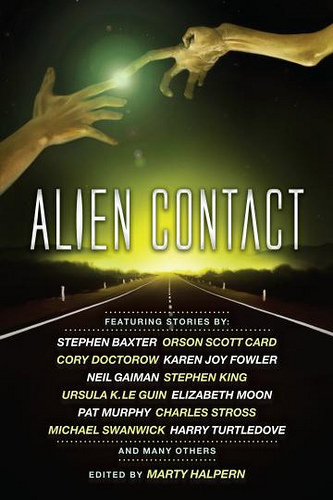 Elias F. Combarro has recently posted his
Alien Contact
Elias F. Combarro has recently posted his
Alien Contact
 (publisher Night Shade Books) review and interview (conmigo) on his Spanish-language blog Sense of Wonder.
(publisher Night Shade Books) review and interview (conmigo) on his Spanish-language blog Sense of Wonder.First, the review.
[Note: If Spanish is not your preferred language, Elias has graciously translated his review into English as well, which is the content from which I will be quoting. However, each page, English or Spanish, links at the bottom to the other version.]
On themed anthologies, Elias writes: "...I don't want to read the same story twenty times. I want to explore many different approaches to the same topic. I want to be surprised and amazed. I want to be shown something new, something that I didn't even imagine that could be done." He goes on to state:
I've recently had the pleasure of reading Alien Contact, an anthology edited by Marty Halpern. It is the perfect illustration of how to assemble a wonderful set of stories devoted to a fascinating theme. All the stories selected by the editor are excellent examples of human contact with alien races (not necessarily a first contact) but no two of them are alike.
[...]
This amazing variety of takes on a single theme is one of the strongest points of the anthology. Throughout all the stories included in the book, we explore, from different points of view, a fascinating topic: ourselves as seen by a stranger.
[...]
The stories of the book are complemented with an invaluable source of information: before Alien Contact was published Marty Halpern blogged about each and every individual tale, providing extremely interesting details and, in some cases, even the full text of some of the stories. While reading the book, I frequently revisited Halpern's notes and that certainly added a lot to the experience.
For the record, the decision to place the authors' biographical notes at the very end of the book was mine alone, as editor. I created a thematic and tonal flow from story to story -- an overall ambiance, I had hoped -- that I felt would have been interrupted by placing mini biographical notes at the beginning (or even at the end) of each individual story. I've had one other person comment similarly on the placement of the authors' bios, so I may reconsider this for any future anthologies.
Now, on to the Alien Contact interview.
[Note: since this interview was conducted in English, Elias then had to translate his questions and my responses into Spanish for his blog readers. Again, regardless of the version, the bottom of each page links to the other version.]
I've done a couple other interviews on my Alien Contact anthology, but Elias (aka "Odo") managed to pose some questions that hadn't been previously asked. Here's one example:
You worked on Alien Contact for about three years and considered more than 150 stories. Is there any particular story that you would have liked to include in the anthology but had to leave out for some reason?To which I responded:
I wanted to include a Philip K. Dick story, "Rautavaara's Case" (OMNI, October 1980), but permission to use the story arrived too late. However, a larger issue for me was having to choose between two (or more) stories by the same author. In a couple instances I had to read stories multiple times in order to make a decision as to which story to select, because all of them were excellent and of the same relative length. I included stories in the anthology by Pat Cadigan, Cory Doctorow, Jeffrey Ford, Nancy Kress, and Michael Swanwick, for example—but I could easily have selected a different story by each of them and still maintained the same overall quality of the book. Though I will admit that the stories I did select were often my own personal favorites....I don't participate in many interviews so it's always a joy (and always a bit of nerves, too) when such an opportunity arises. I'd like to take this time to thank Elias -- and his Sense of Wonder readers -- for the opportunity to respond to a few questions regarding my Alien Contact project. I'd also like to thank Elias for his willingness to translate his Spanish-language review into English.

Published on May 09, 2012 12:07
May 8, 2012
Let the wild rumpus begin....
Published on May 08, 2012 20:30
May 7, 2012
April Links & Things
This is my monthly wrap-up of April's Links & Things. You can receive these links in real time by following me on Twitter: @martyhalpern; or Friending me on Facebook (FB). Note, however, that not all of my tweeted/FB links make it into these month-end posts. April was a very busy month, so there is a lot of content here; please return to this blog if necessary to take full advantage of all the links. Previous month-end posts are accessible via the "Links and Things" tag in the right column.
Philip K. Dick passed away shortly before the release of the Blade Runner movie. But, PKD did catch "his first glimpse of Blade Runner in a television segment," after which he wrote this wondrous letter to the Ladd Company, one of the film's production companies. The PKD Estate believes this is the first time the letter has been made public: "...I came to the conclusion that this indeed is not science fiction; it is not fantasy; it is exactly what Harrison said: futurism. The impact of BLADE RUNNER is simply going to be overwhelming, both on the public and on creative people -- and, I believe, on science fiction as a field." [all emphasis is PKD's] (@WordandFilm via @PantheonBooks)
Grim_Noir on the PopTards blog revisits George Alec Effinger's Maríd Audran series of books 30 years later: When Gravity Fails, A Fire in the Sun, The Exile Kiss, and Budayeen Nights (which I acquired and edited for Golden Gryphon Press; here is my lengthy blog post on the making of Budayeen Nights, part one of three on my edited GAE books). Grim_Noir writes: "THIS is what Blade Runner wants to be when it grows up. (And I say that with the upmost respect for Philip K. Dick, Ridley Scott, Harrison Ford AND Blade Runner.)...Thirty years after it was originally published, George Alec Effinger's Audran Sequence is STILL ahead of its time. The writing is sharp and goes straight at the gut, like a turbo-charged razorblade." (via Gordon Van Gelder's Facebook page)
After twenty-one years of teaching English Literature at Oakdale Community College in New Jersey, author Jeffrey Ford has retired from the teaching profession to write full time in upstate New York. One of Jeff's former students, Matthew Sorrento, pays tribute to his mentor, in this very personal post on Matthew's Identity Theory (@IdentityTheory) blog. For an instructor, it doesn't get any better than this.
On Amazon's Omnivoracious blog, Susan J. Morris (@susanjmorris) writes about "Engaging Readers on Page One" with a blog post entitled "Brilliant Beginnings." Susan covers the three most common "False Starts": Waking Up, Fight Scenes, and Origin Stories...of the Universe.
Speaking of first pages and opening lines: Glamour in Glass, the new novel by Mary Robinette Kowal (@MaryRobinette), is missing its opening line. The sentence was there during the review of the page proofs, but then, shazam! -- it disappeared in the published edition. But not one to miss an opportunity, Mary has turned the missing line into a game, a t-shirt, and more.
This next entry was actually posted in March, but it didn't come to my attention until April: Adam Ruben's Experimental Error column in Science magazine's careers section tells us "How to Write Like a Scientist." "Why can't we write like other people write? Why can't we tell our science in interesting, dynamic stories? Why must we write dryly? (Or, to rephrase that last sentence in the passive voice, as seems to be the scientific fashion, why must dryness be written by us?)" (via @GrammarGirl and @literalminded)
How many ways do you know to piss off an editor? James L. Sutter, in a guest post on Inkpunks, provides us with all 9 ways: 1) Overconfidence; 2) Underconfidence; 3) Being a Pretty Princess; 4) Failure to Thrive; 5) No Website; 6) Going Dark; 7) Stalking; 8) Carelessness; and 9) Missing Deadlines. Check the link for a lot of detail behind each point. (via ChiZine Publications' FB page)
The Creative Penn blog (@thecreativepenn), which I reference quite often in these monthly wrap-ups, has another fine guest post, this one by author Matt Garland entitled "Professional Editors: The Smart Writer’s #1 Competitive Advantage." Matt writes: "Indie authors need a serious competitive advantage to earn respect and win readers’ hearts and minds. Without one, the odds of tilting the indie author playing field in their favor to attract eyeballs, establish credibility and gain loyal readers are impossibly stacked against them. So what's a smart indie author to do?" Matt recommends teaming up with a professional editor. He then details 5 points on how valuable an editor can be to an indie author.
Author Bradley P. Beaulieu guest blogs on The Mad Hatter's Book Review (@madhatterreview) with "Growing Pains: Lessons in Writing the Sequel." Author of The Winds of Khalakovo, and its sequel The Straits of Galahesh, Bradley writes: "While writing STRAITS I started to grow more aware of just how hard it is to write metaphysical stuff...."
Glimmer Train is a literary print magazine that has been known to include stories of the fantastic (don't tell them that I said this!); one of their authors, Brad Beauregard, shares some thoughts on "Where Can I Find Some Style": "...style isn't an outfit we don and toss in the laundry at night's end. Style is a body roadmapped with scars and tattoos, the sediment of time spent struggling, failing, and starting over. Style is the house you accidentally build while you're tearing walls down and throwing them in the burn pile. But most important, style is the thing writers struggle against, not toward." (via Jane Friedman's FB page)
Have you ever struggled with the title of a short story? A novel? Or even a blog post? That may be a good sign! In yet another guest blog post, on Ebon Shores, author and editor Cat Sparks shares some straight talk "On the importance of titles and why you should put some effort into ensuring yours don't suck." (via @editormum75)
The Center for Fiction hosts a series of blog posts by writers on writing, and in this post Dani Shapiro (@danijshapiro) talks about her never-ending fight against procrastination. "But then, finally, there comes a turning point. Finally, it is more difficult and painful not to write than to write. The not-writing feels untenable, unbearable. The feeling, for me, is a kind of exquisite despair. Here goes nothing, I think to myself. What do I have to lose? Pen poised over paper, the world recedes. And I remember again...that this is what it's all about. One word connecting, leading, to another, then another...." (via @Sirenland)
Andrew Zimmerman Jones, science writer for PBS's NOVA, poses the question: "Can science fiction influence the course of real science?" in a blog post entitled "Writing a Bold Future, Together."
Nathan Bransford (@NathanBransford), in an article for CNET News, explains "Why e-books cost so much." This article is in response, so to speak, to the current Justice Department case against ebook publishers for "allegedly colluding to raise e-book prices." Whether you agree or disagree, Nathan rolls out the numbers for an example of the "Wholesale model e-book" and the "Agency model e-book." And be sure to check out the 285 comments!
Author and editor Dario Ciriello writes about "Acting As If" -- "act as if, to pretend that we have the chops we actually don't yet; or, as Pat Cadigan once put it, 'show me what you wish you had.'"...it will "free you up, give you the space to play again, allow you to act spontaneously. It changes your line of attack from timid to confident, from negative expectations to no expectations, from fear to fun."
Stephen King has been in the news of late for both his newest Dark Tower book, The Wind Through the Keyhole, as well as his (political? economic? apocalyptic?) rant in The Daily Beast (@thedailybeast): "Tax Me, for F@%&'s Sake!" The header on the article reads: "The iconic writer scolds the superrich (including himself—and Mitt Romney) for not giving back, and warns of a Kingsian apocalyptic scenario if inequality is not addressed in America."
For all you convention participants, I'll close this link wrap-up with a blog post from Jay Lake (@jay_lake) on convention panel etiquette: "I cannot begin to count the number of occasions where the reading or panel before mine has run long, right up to the transition point, or even beyond it. Which is profoundly disrespectful to both audiences (exiting and entering) as well as the pros scheduled to have the room next. And wastes the time of a hell of a lot of people."


Philip K. Dick passed away shortly before the release of the Blade Runner movie. But, PKD did catch "his first glimpse of Blade Runner in a television segment," after which he wrote this wondrous letter to the Ladd Company, one of the film's production companies. The PKD Estate believes this is the first time the letter has been made public: "...I came to the conclusion that this indeed is not science fiction; it is not fantasy; it is exactly what Harrison said: futurism. The impact of BLADE RUNNER is simply going to be overwhelming, both on the public and on creative people -- and, I believe, on science fiction as a field." [all emphasis is PKD's] (@WordandFilm via @PantheonBooks)
Grim_Noir on the PopTards blog revisits George Alec Effinger's Maríd Audran series of books 30 years later: When Gravity Fails, A Fire in the Sun, The Exile Kiss, and Budayeen Nights (which I acquired and edited for Golden Gryphon Press; here is my lengthy blog post on the making of Budayeen Nights, part one of three on my edited GAE books). Grim_Noir writes: "THIS is what Blade Runner wants to be when it grows up. (And I say that with the upmost respect for Philip K. Dick, Ridley Scott, Harrison Ford AND Blade Runner.)...Thirty years after it was originally published, George Alec Effinger's Audran Sequence is STILL ahead of its time. The writing is sharp and goes straight at the gut, like a turbo-charged razorblade." (via Gordon Van Gelder's Facebook page)
After twenty-one years of teaching English Literature at Oakdale Community College in New Jersey, author Jeffrey Ford has retired from the teaching profession to write full time in upstate New York. One of Jeff's former students, Matthew Sorrento, pays tribute to his mentor, in this very personal post on Matthew's Identity Theory (@IdentityTheory) blog. For an instructor, it doesn't get any better than this.
On Amazon's Omnivoracious blog, Susan J. Morris (@susanjmorris) writes about "Engaging Readers on Page One" with a blog post entitled "Brilliant Beginnings." Susan covers the three most common "False Starts": Waking Up, Fight Scenes, and Origin Stories...of the Universe.
Speaking of first pages and opening lines: Glamour in Glass, the new novel by Mary Robinette Kowal (@MaryRobinette), is missing its opening line. The sentence was there during the review of the page proofs, but then, shazam! -- it disappeared in the published edition. But not one to miss an opportunity, Mary has turned the missing line into a game, a t-shirt, and more.
This next entry was actually posted in March, but it didn't come to my attention until April: Adam Ruben's Experimental Error column in Science magazine's careers section tells us "How to Write Like a Scientist." "Why can't we write like other people write? Why can't we tell our science in interesting, dynamic stories? Why must we write dryly? (Or, to rephrase that last sentence in the passive voice, as seems to be the scientific fashion, why must dryness be written by us?)" (via @GrammarGirl and @literalminded)
How many ways do you know to piss off an editor? James L. Sutter, in a guest post on Inkpunks, provides us with all 9 ways: 1) Overconfidence; 2) Underconfidence; 3) Being a Pretty Princess; 4) Failure to Thrive; 5) No Website; 6) Going Dark; 7) Stalking; 8) Carelessness; and 9) Missing Deadlines. Check the link for a lot of detail behind each point. (via ChiZine Publications' FB page)
The Creative Penn blog (@thecreativepenn), which I reference quite often in these monthly wrap-ups, has another fine guest post, this one by author Matt Garland entitled "Professional Editors: The Smart Writer’s #1 Competitive Advantage." Matt writes: "Indie authors need a serious competitive advantage to earn respect and win readers’ hearts and minds. Without one, the odds of tilting the indie author playing field in their favor to attract eyeballs, establish credibility and gain loyal readers are impossibly stacked against them. So what's a smart indie author to do?" Matt recommends teaming up with a professional editor. He then details 5 points on how valuable an editor can be to an indie author.
Author Bradley P. Beaulieu guest blogs on The Mad Hatter's Book Review (@madhatterreview) with "Growing Pains: Lessons in Writing the Sequel." Author of The Winds of Khalakovo, and its sequel The Straits of Galahesh, Bradley writes: "While writing STRAITS I started to grow more aware of just how hard it is to write metaphysical stuff...."
Glimmer Train is a literary print magazine that has been known to include stories of the fantastic (don't tell them that I said this!); one of their authors, Brad Beauregard, shares some thoughts on "Where Can I Find Some Style": "...style isn't an outfit we don and toss in the laundry at night's end. Style is a body roadmapped with scars and tattoos, the sediment of time spent struggling, failing, and starting over. Style is the house you accidentally build while you're tearing walls down and throwing them in the burn pile. But most important, style is the thing writers struggle against, not toward." (via Jane Friedman's FB page)
Have you ever struggled with the title of a short story? A novel? Or even a blog post? That may be a good sign! In yet another guest blog post, on Ebon Shores, author and editor Cat Sparks shares some straight talk "On the importance of titles and why you should put some effort into ensuring yours don't suck." (via @editormum75)
The Center for Fiction hosts a series of blog posts by writers on writing, and in this post Dani Shapiro (@danijshapiro) talks about her never-ending fight against procrastination. "But then, finally, there comes a turning point. Finally, it is more difficult and painful not to write than to write. The not-writing feels untenable, unbearable. The feeling, for me, is a kind of exquisite despair. Here goes nothing, I think to myself. What do I have to lose? Pen poised over paper, the world recedes. And I remember again...that this is what it's all about. One word connecting, leading, to another, then another...." (via @Sirenland)
Andrew Zimmerman Jones, science writer for PBS's NOVA, poses the question: "Can science fiction influence the course of real science?" in a blog post entitled "Writing a Bold Future, Together."
Nathan Bransford (@NathanBransford), in an article for CNET News, explains "Why e-books cost so much." This article is in response, so to speak, to the current Justice Department case against ebook publishers for "allegedly colluding to raise e-book prices." Whether you agree or disagree, Nathan rolls out the numbers for an example of the "Wholesale model e-book" and the "Agency model e-book." And be sure to check out the 285 comments!
Author and editor Dario Ciriello writes about "Acting As If" -- "act as if, to pretend that we have the chops we actually don't yet; or, as Pat Cadigan once put it, 'show me what you wish you had.'"...it will "free you up, give you the space to play again, allow you to act spontaneously. It changes your line of attack from timid to confident, from negative expectations to no expectations, from fear to fun."
Stephen King has been in the news of late for both his newest Dark Tower book, The Wind Through the Keyhole, as well as his (political? economic? apocalyptic?) rant in The Daily Beast (@thedailybeast): "Tax Me, for F@%&'s Sake!" The header on the article reads: "The iconic writer scolds the superrich (including himself—and Mitt Romney) for not giving back, and warns of a Kingsian apocalyptic scenario if inequality is not addressed in America."
For all you convention participants, I'll close this link wrap-up with a blog post from Jay Lake (@jay_lake) on convention panel etiquette: "I cannot begin to count the number of occasions where the reading or panel before mine has run long, right up to the transition point, or even beyond it. Which is profoundly disrespectful to both audiences (exiting and entering) as well as the pros scheduled to have the room next. And wastes the time of a hell of a lot of people."

Published on May 07, 2012 13:51





